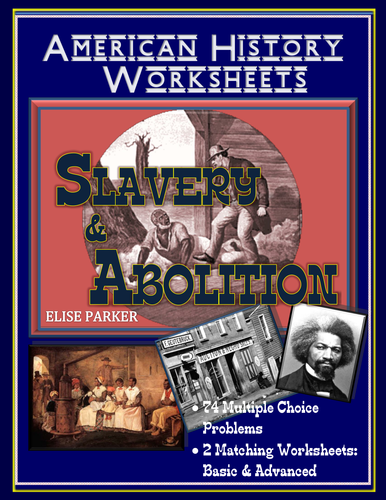
Three Slavery and Abolition worksheets: Multiple choice with 74 questions for a thorough review or test, plus 2 matching worksheets -- one basic, one advanced so you can have differentiated learning materials at your fingertips!
All three of these Slavery Worksheets / Abolition Worksheets cover the same basic content: the institution of slavery in the United States from about 1800 through 1860, as well as the growing abolition movement taking hold of the nation during that time.
The first worksheet is a comprehensive multiple-choice exercise focused on slavery and abolition, containing 74 questions that can be answered using most high-school level textbooks or online resources related to United States slavery in the 1800s.
The last two worksheets consist of matching problems designed to help students do a targeted review of key people and items that they should have mastered. Because the matching worksheets focus only on these highly important historical entries, they work very well as quizzes or tests.
Matching Worksheet A is the “basic” version of such a test because there are no extraneous answers provided as distractors. Teachers may find that Worksheet A is perfect for students who benefit from more streamlined materials.
Matching Worksheet B, on the other hand, is the “advanced” version of the same test. Questions and answers are identical to those on the “ basic” matching worksheet, but additional unused answers are also mixed in so that students have more entries to choose from.
CONTENT INCLUDED IN THESE SLAVERY WORKSHEETS / ABOLITION WORKSHEETS
These question cover the following range of topics commonly studied in U.S. history / American history classes:
• Anti-slavery societies and the plan for resettlement of freed slaves in Africa
• Influence of preachers / ministers / religion in the abolition movement
• William Lloyd Garrison and his abolitionist newspaper, The Liberator
• David Walker and his call for slaves to fight for their freedom
• Frederick Douglass and his abolitionist newspaper, The North Star
• Conditions for rural and urban slaves in the 1800s
• Solomon Northrup and his experiences as 12 Years a Slave
• Nat Turner’s Rebellion
• Slave codes
• Justifications for slavery
• Petitions for abolition in the nation’s capital, and the “gag rule” reaction
All three of these Slavery Worksheets / Abolition Worksheets cover the same basic content: the institution of slavery in the United States from about 1800 through 1860, as well as the growing abolition movement taking hold of the nation during that time.
The first worksheet is a comprehensive multiple-choice exercise focused on slavery and abolition, containing 74 questions that can be answered using most high-school level textbooks or online resources related to United States slavery in the 1800s.
The last two worksheets consist of matching problems designed to help students do a targeted review of key people and items that they should have mastered. Because the matching worksheets focus only on these highly important historical entries, they work very well as quizzes or tests.
Matching Worksheet A is the “basic” version of such a test because there are no extraneous answers provided as distractors. Teachers may find that Worksheet A is perfect for students who benefit from more streamlined materials.
Matching Worksheet B, on the other hand, is the “advanced” version of the same test. Questions and answers are identical to those on the “ basic” matching worksheet, but additional unused answers are also mixed in so that students have more entries to choose from.
CONTENT INCLUDED IN THESE SLAVERY WORKSHEETS / ABOLITION WORKSHEETS
These question cover the following range of topics commonly studied in U.S. history / American history classes:
• Anti-slavery societies and the plan for resettlement of freed slaves in Africa
• Influence of preachers / ministers / religion in the abolition movement
• William Lloyd Garrison and his abolitionist newspaper, The Liberator
• David Walker and his call for slaves to fight for their freedom
• Frederick Douglass and his abolitionist newspaper, The North Star
• Conditions for rural and urban slaves in the 1800s
• Solomon Northrup and his experiences as 12 Years a Slave
• Nat Turner’s Rebellion
• Slave codes
• Justifications for slavery
• Petitions for abolition in the nation’s capital, and the “gag rule” reaction
Something went wrong, please try again later.
This resource hasn't been reviewed yet
To ensure quality for our reviews, only customers who have purchased this resource can review it
Report this resourceto let us know if it violates our terms and conditions.
Our customer service team will review your report and will be in touch.
$6.00
